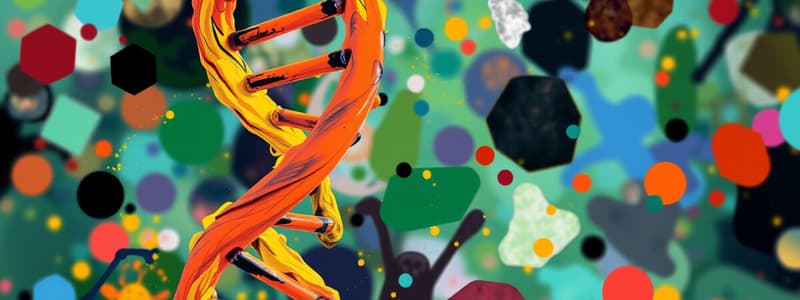Podcast
Questions and Answers
What does DNA stand for?
What does DNA stand for?
- Deoxyribonucleotides Nucleotide
- Deoxyribose Protein
- Decarboxylic Nucleotide Acid
- Deoxyribose Nucleic Acid (correct)
What structure contains genetic material (DNA)?
What structure contains genetic material (DNA)?
Nucleus
Where does translation happen?
Where does translation happen?
Cytoplasm
What is the role of ribosomes?
What is the role of ribosomes?
What makes the bonds between amino acids?
What makes the bonds between amino acids?
What is the function of tRNA?
What is the function of tRNA?
What is the basic unit of all forms of life?
What is the basic unit of all forms of life?
What carries the instructions for assembling proteins from DNA?
What carries the instructions for assembling proteins from DNA?
What type of sugar is found only in RNA?
What type of sugar is found only in RNA?
What enzyme bonds nucleotides onto the DNA strand?
What enzyme bonds nucleotides onto the DNA strand?
What is the difference between tRNA and mRNA?
What is the difference between tRNA and mRNA?
What is a nucleotide composed of?
What is a nucleotide composed of?
What is ultimately made during translation?
What is ultimately made during translation?
What nitrogen base pairs with adenine in RNA?
What nitrogen base pairs with adenine in RNA?
What are sets of three nitrogen bases called?
What are sets of three nitrogen bases called?
What does a mutation affect?
What does a mutation affect?
What is the shape that DNA forms?
What is the shape that DNA forms?
What sugar is part of nucleotides in DNA?
What sugar is part of nucleotides in DNA?
What is part of both DNA and RNA?
What is part of both DNA and RNA?
Is mRNA synthesized in translation or transcription?
Is mRNA synthesized in translation or transcription?
Does mRNA have codons or anticodons?
Does mRNA have codons or anticodons?
Where is mRNA synthesized?
Where is mRNA synthesized?
How many codons equal one amino acid?
How many codons equal one amino acid?
Does tRNA bring amino acids to the nucleus or ribosome?
Does tRNA bring amino acids to the nucleus or ribosome?
What is a polypeptide made of?
What is a polypeptide made of?
Does tRNA have codons or anticodons?
Does tRNA have codons or anticodons?
Does tRNA transfer amino acids during translation or transcription?
Does tRNA transfer amino acids during translation or transcription?
Where do ribosomes carry out their function?
Where do ribosomes carry out their function?
How many nitrogen bases equal one amino acid?
How many nitrogen bases equal one amino acid?
How many different amino acids are there?
How many different amino acids are there?
What type of bond binds amino acids together?
What type of bond binds amino acids together?
Flashcards are hidden until you start studying
Study Notes
Genetic Material and Structure
- DNA: Deoxyribose Nucleic Acid composed of nucleotides (adenine, cytosine, thymine, guanine).
- Nucleus: Contains genetic material (DNA), site of DNA replication and transcription.
- Cytoplasm: Location where translation occurs.
Protein Synthesis Components
- Ribosome: Site of translation in the cytoplasm, links amino acids to form proteins.
- Polypeptide: Sequence formed by bonding amino acids together.
- mRNA: Carries instructions for assembling amino acids into proteins from DNA.
RNA Types and Functions
- tRNA (Transfer RNA): Brings amino acids to ribosomes; contains anticodons for complementary pairing during translation.
- RNA Polymerase: Enzyme that binds to DNA to separate strands during transcription.
- Anticodons: Found in tRNA; pairs with mRNA codons during translation.
Nucleotides and Their Role
- Nucleotides: Building blocks of nucleic acids, composed of a five-carbon sugar, phosphate group, and nitrogenous base (A, T, C, G).
- Ribose Sugar: Present in RNA, essential for ribosome structure.
- Deoxyribose Sugar: Component of DNA nucleotides.
Gene Expression and Mutations
- Codons: Triplet sequences on mRNA that code for amino acids.
- Mutations: Changes in DNA sequence that can be beneficial, detrimental, or neutral.
Structural Characteristics
- Double Helix: DNA configuration, with two strands running parallel in opposite directions (5' to 3').
- Phosphate Group: Integral part of nucleotides in both DNA and RNA.
Key Relationships in Translation and Transcription
- Translation: Process of amino acid sequence formation, occurring at the ribosome.
- Transcription: Synthesis of mRNA in the nucleus from DNA templates.
- Amino Acids: Basic units that are sequenced to form proteins during translation.
Additional Facts
- Three nitrogen bases correspond to one amino acid.
- Total amino acids in proteins: 20 different types.
- Peptide Bond: Type of bond that connects amino acids in a protein.
Studying That Suits You
Use AI to generate personalized quizzes and flashcards to suit your learning preferences.




